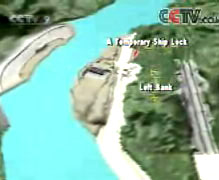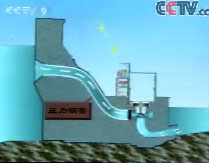 After 10 years of construction, the world-famous Three Gorges Project entered a new stage on June 1 when filling of the reservoir began. It will soon bring both economic benefits and help control floods. After 10 years of construction, the world-famous Three Gorges Project entered a new stage on June 1 when filling of the reservoir began. It will soon bring both economic benefits and help control floods.
In 1993, the Chinese government made a historic decision, giving birth to the world’s largest water project, the Three Gorges Dam. After the 10 years of construction, filling of the reservoir behind the dam began in June this year. The project will soon bring real benefits to the region and the country.
The Three Gorges Reservoir is hugely important to China’s social and economic development. The next few years will show whether it was worth the huge investment and laborious construction which will have lasted more than a decade and a half.
The Three Gorges are located at the upper reaches of the trunk stream of the Yangtze River. The small island of Zhongbao separated this reach into two parts: Dajiang and Houhe. Lying on the right bank of the downstream Yangtze River, Houhe was surrounded with a cofferdam in 1993 when the government gave the go-ahead for the Three Gorges Project. After the water there was removed, Houhe was deepened and widened to form a water diversion channel. At the same time, a temporary shiplock was built on the left bank of the Yangtze River to ensure smooth navigation and flood discharge. In May 1997, the cofferdam was demolished, leaving the channel a virtually man-made section of the Yangtze River. In November 1997, the Yangtze River was blocked. Then a second cofferdam was built, forming the basis of a new dam and a power station. Then a permanent ship lock replaced the temporary one. In May 2002, the second cofferdam was demolished and the Yangtze River flowed through the flood discharge gate. In November 2002, a concrete cofferdam was built after the water had been removed from the diversion channel. In June this year, filling of the Three Gorges Reservoir began, preparing for future navigation.
“When we receive the order, we will shut down the lock gate to raise the water level in the upper reach. We can choose which gate we want to close. For instance, if we want to close the No. 9 bottom outlet, we just choose this and press the button. The order will be completed within seconds,” said Du Xiongchun, deputy director of Operation Department of Three Gorges Hydropower Station.
According to Peng Qiyou, director of Construction Department of Three Gorges Project, given the current progress of filling and the normal water flow, based on the rate of flow for 85 of the last one hundred years, the water level will not rise more five meters per day. Generally speaking, it is about two to three meters.
“According to the estimated rate of flow, the water level should reach about 135 meters around June 13. After two or three days of further preparations, we’ll arrange trial navigation on June 16. That means that the two-way ship lock will be put to use. After the water level reaches 135 meters, we’ll conduct a flushing test to ensure the combined power generation of the two generators. In October this year, another two generators will start running. We are aiming to produce 5.5 billion kilowatt hours this year,” said Li Yong’an, deputy executive manager of Three Gorges Project Development Corporation.
With the start of the filling process, the Three Gorges Project has begun to yield benefits. One of the benefits is flood control. The trunk stream of the Yangtze River runs 6,300 kilometers. Over the past 2,100 years, it suffered 216 big floods, an average of one per decade. Four major floods occurred in the last century: in 1931, 1935, 1954, and 1988.
“After the filling is completed, there will be a big reservoir. With the water level at 135 meters, a total of 12.4 billion cubic meters will be stored. We can also exploit the elevation above which is nearly 6.5 meters. Thus, any big flood from the upper reaches will be slowed down through flood detention and staggered flood peaks. Consequently, the rate of flood flow will be well below the flood control level, ensuring maximum safety in the lower reaches,” said Peng Qiyou.
 Until 2009 when the Three Gorges Project is completed, the designed storage capacity will be 22.15 billion cubic meters. The Three Gorges Reservoir then will be able to contain 90 percent of a flood from the Jingjiang River section.
Until 2009 when the Three Gorges Project is completed, the designed storage capacity will be 22.15 billion cubic meters. The Three Gorges Reservoir then will be able to contain 90 percent of a flood from the Jingjiang River section.
“After the Three Gorges Project is finished, it will play a key role in flood control in the middle and lower reaches of the Yangtze River. Firstly, as far as the Jingjiang River section is concerned, the current standard for flood control is to ensure that floods take place no more than once per decade. With the Three Gorges Project completed, the number of floods will be limited to one per century. Secondly, as far as the Dongtinghu Lake is concerned, once the Three Gorges Project is completed, it’ll help decrease the flooding area if a big flood takes place. Finally, the completion of the Three Gorges Project will bring protective measures in dealing with super floods from the upper reaches. By adjusting the water level in the Three Gorges Reservoir, the flood discharge volume will be controlled to some extent. Safe flood discharge can be realized,” said Zhong Zhiyu, deputy executive engineer of Institute of Survey and Design of Yangtze Water Conservancy River Commission.
The second benefit that the Three Gorges Project will bring is electric power generation. Based on the Three Gorges dam, there will be one hydropower station on each bank of the Yangtze River. After the filling of the Three Gorges Reservoir is finished, there will be a drop of dozens of meters from the top water level to the bottom. The water will flow into the sluice gate and drive the water turbine. Then the power generator will start to generate electricity.
One hydropower station on the left bank has already been built. Four turbine generators will be installed this year with the generation capacity reaching 2.8 million kilowatts, surpassing the capacity of the Gezhouba dam. In the Three Gorges Project, a total of 26 turbine generators will be operating in the two hydropower stations on each bank.
“Right now, two turbine generators on the left bank hydropower station have been installed and tested. They are ready for the flushing test. After today’s flushing test, we need to check the discharge sections before the water level reaches 135 meters. We’ll lift the tail water gate and start the water flushing in the draft tube. We’ll then lift the water inlet and start water flushing in the sluice gate. If no problems are found during the complete check, the first generators will formally start running on June 15,” said Huang Hongyong, head of Monitoring Department of Three Gorges Hydropower Station.
“The generation volume this year will be 5.5 billion kilowatt hours. We’ll transmit this mainly to eastern and central China. From this year on, there will be an average of four generators with a capacity of 700,000 kilowatt put into operation. That is to say we’ll have the equivalent of one new Gezhouba hydropower station each year in terms of capacity. From next year, electricity generated here will be transmitted to Guangdong Province. The power generation of the Three Gorges will promote, to some extent, economic development in eastern and central China as well as Guangdong province. Being the center of China’s electrical load, the completion of the Three Gorges Hydropower Stations will be critical to the national electricity network and electricity transmission from western China to the east,” said Li Yong’an.
Its annual power generation is estimated to average 84.7 billion kilowatt hours, 10 times the capacity of Dayawan nuclear power station.
Navigation is the third benefit brought by the Three Gorges Project. When it is full, the navigation channel of the Yangtze River will be widened and more convenient for shipping. At the same time, the permanent ship lock built in the Three Gorges dam will be the world’s highest in terms of water altitude and will have the largest number of inland river ship locks.
“After the second phase of construction is completed, we’ll prepare well for the third phase. Between 2004 and 2009 we’ll complete the construction of the right bank dam and the power station. When the whole Three Gorges Project is completed, a total of 26 generators will be put into operation. Then we’ll be able to transmit clean energy to the whole country, making our contribution to the social and economic development of China,” said Li Yong’an.
|